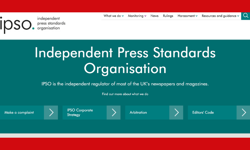Cheryl is too thin. Amal is too thin and has bunions. Col-Leen has lost her “baby tum” in just two months.
Kate is too thin, has bunions and lost her baby tum in two weeks. She also has a few grey hairs and looked jolly tired in the run-up to Christmas.
But at least Myleene always looks Klassy.
We learn all this not from celebrity mags picked up at the supermarket, but from national newspapers.
We also learn from national newspapers that a third of women are on a permanent diet, that young women have less confidence than their parents and that a generation of teenagers is unhappy because they think they are fat.
Newspapers are further concerned about the shortage of women in parliament and in the boardroom, about the gender pay gap, and even that women end up paying more for some commodities.
But, of course, none of that has anything to do with the portrayal of women in newspapers. Newspapers which, given the way they dictate to the government, apparently see it as their job not only to reflect, but also to shape and influence society.
It’s just the way it is.
Or the fault of social media.
The Mail has never been shy of saying exactly what it thinks about anyone with any kind of public persona who is snapped walking down the street, but judgmental headings and captions are now common in other titles. They all want to tap into that “sidebar of shame” online success and none recognises that what creates traffic on the web does not necessarily work in print.
An unshaven Hollywood actor in a scruffy t-shirt might find himself on the receiving end of this kind of treatment, but the overwhelming majority of the victims are women.
Some of this personal attention is intended to be flattering in the “Wow! Doesn’t she look fab” mould. But it is still personal and often unwanted. Yes, Myleene Klass sells swimsuits and the sharp pictures of her in flamboyant poses suggest that she is well aware of the cameras. But what of Coleen Rooney on holiday on a beach with her children (and why are their faces being shown)?
At big race meetings, women do not even have to be public figures to come under scrutiny. These “fillies” are ridiculed for showing too much boob, for falling off their high heels, for drinking a glass or two more bubbly than is wise.
What’s new about any of this? Newspapers have been printing photographs of attractive women since the year dot. Well, since Sir John Junor’s day anyway, which is pretty much the same thing.
Overkill
What is new is the proliferation of these pictures and the running commentary on women’s behaviour. The Sun used to run a bare-breasted woman on page 3 every day. It stopped doing that last year. Now it carries pictures of women in varying states of undress on pages 3, 5, 7, 13, 21, 25 and 29. In March this year, it printed more than 250 such photographs. They included glamour shots of a woman who had “borrowed” a BMW and another who had stolen a £28,000 watch. The Daily Star, which picked up the page 3 topless model mantle, managed a mere 217.
When Kim Kardashian put out that selfie, the Sun was beside itself. Not content with running the picture and being done with it, every columnist had to have their say, there was a “news” story about a Sun-confected condition it called Attention Nakedness Disorder, there were a couple of other celebs copying the pose with its pair of black bands, there were half a dozen readers doing the same thing, and there was Rod Liddle showing rather more flesh peeping out of the bands than most would wish to see over their cornflakes. Then there were the little drop-in shots to remind readers what the columnists were mocking, and even one to accompany an unrelated picture of sister Khloe. In one Sunday issue of the paper, the original Kim selfie appeared four times.
The Kardashian example is extreme, but the Sun is developing a habit of using three pictures where once it would have been happy with one. There were six on a spread of Rita Ora doing the can-can, plus a drop-in mugshot and a teaser on the front. When Madonna went into meltdown in the tussle over her son Rocco, the paper was there to record every tortured moment with three pictures a day on three successive days. This was a genuine news story and the singer was in a state when onstage, so coverage was absolutely justified, but the extent of it was bordering on cruel.
Unfortunately, neither Sun editor Tony Gallagher nor head of PR Dylan Sharpe was willing to respond to questions about this abundance of cleavage (there was also analysis of Theresa May’s political assets and a competition for readers to send in selfies of their embonpoint), but one Sun old-timer, who asked to remain anonymous, has a theory:
“I think the multitude of almost-identical glam pix is the result of two things: laziness and panic.
“Laziness because it becomes the easy option to sling in half a dozen samey pix, and it also absolves anyone from that awkward business of having to make a decision. If the night editor under Kelvin had used six pix of the same bird in the same attitude, his ass would have been out on the highway. It doesn't say much for the imagination of the production departments - unless, of course, they are under orders to cram in as much of this flotsam as possible.
“Panic because The Sun is in dire financial straits as advertisers jump ship over plunging sales. The management are scared by the speed of the decline and the inroads made by Desmond and the Star.”
Another former Sun exec noted that former Telegraph editor Gallagher had been brought in to put a more serious stamp on the paper. He described the cleavage competition as “cringe-makingly awful”, adding: “Even the Daily Star might deem it beyond the pale. How can you swing elections or be taken seriously with page after page of lorry drivers' wives getting their kit off?”
The Sun remains the country’s best-selling newspaper, while the Star promotes itself as the fastest growing. But it was a price cut, rather than bare boobs, that arrested the decline that had seen the Star’s circulation fall by 35% in three and a half years. Both are eclipsed in total readership by the Mail, which is not only way out in front online, but is now within shouting distance of the Sun in print as well.
In February 2012, The Sun was selling 2.6m papers a day against the Mail’s 1.9m. Four years on, The Sun was down to 1.75m with the Mail just 180,000 behind at 1.56m. The Star sells 472,869 a day against 617,000 in February 2012.
The Diana effect
How do women fit into this equation? There was a belief in the 80s that a picture of Diana on a cover would boost sales and that extended to a general preference for photographs of women. Well, yes, an attractive young woman is more appealing to both men and women than an old man in a suit. But is there evidence that the choice of image influences circulation?
Back to the former Sun exec who was sniffy about readers’ wives:
“We did indeed apply an analytical approach to page one glam pix which proved that a significant sales bump could be achieved by certain celebs. The circulation manager kept charts and records about which star did particularly well and in what circumstances - was it a big football night so you got a double whammy, or was there a big interview inside which provided a peg?
“We deployed glam on page one as a weapon - if we knew the Mirror had something decent, we would do a big spoiler headline and a four-col drop-dead gorgeous pic of someone we knew sold well in a state of semi-undress. There’s no harm in that swashbuckling rivalry for a popular paper, but there was also a self-awareness not to overdo it, because we didn't want to be the Daily Star, we wanted to be The Sun.”
Today there are even more sophisticated measuring tools and algorithms that must go some way to explaining why Rita Ora is so ubiquitous.
In the first three months of this year, there were 222 photographs of women as the main image on the front pages of our national newspapers, against 178 of men. And those months saw the deaths of David Bowie and Terry Wogan, who both achieved a clean sweep, so the gap was smaller than it might otherwise have been.
There were also 53 photographs of couples where the story was exclusively about the male half of the pair. The late Natasha Richardson, for example, appeared alongside her widower Liam Neeson, who had said he was dating someone famous but had declined to say who.
Any excuse
When Simon Danczuk sent inappropriate texts to a 17-year-old, The Sunday Times gave us his ex-wife Karen in boxing vest, shorts and gloves; when Vernon Kay was similarly caught out, we were treated not only to bikini shots of the glamour model recipient, but also of his wife Tess Daly.
Setting aside the royals, all the men who made the front pages had some relevance to one of the stories; only 60 of the women had done anything beyond look pretty in swimwear or on the red carpet or in a new TV show.
They included a handful of crime victims, two murder suspects and a thief. One won a lot of money on the lottery and another didn’t but “thought” she had.
Adele and Madonna were clearly worth their slots for their musical successes and disasters. Ditto Laura Trott, Johanna Konta and Maria Sharapova in the sporting arena.
Anita Brookner, Natalie Cole, Harper Lee and Nancy Reagan earned their places by dying, Jerry Hall by marrying some media magnate, Shami Chakrabarti by stepping down after years of running Liberty, and Mirga Gražinytė-Tyla by becoming musical director of the CBSO – the one truly notable achievement by any of the women featured over the three months, and then recognised only by The Times.
The feast of femininity included only half a dozen politicians. Angela Merkel, the most powerful woman in the world and a key figure in Britain’s future relations with Europe, turned up twice. Not young or pretty enough.
This isn’t about “humourless” feminism. There’s nothing wrong with a bit of teasing. Even Page 3 was ok when it was just Page 3. It is the relentless, poisonous mix of ogling and bitching on page after page that is dispiriting.
Where are the role models?
As Eleanor Mills, executive editor of The Sunday Times and chair of the Women in Journalism organisation, observes: women tend to appear in papers as either victims or accessories. As editor of her paper’s magazine, she says: “I try to make sure that every issue features women with agency – doing something in their own right. I want to be able to show my daughters ‘this is the kind of woman you can be’. You can’t be what you can’t see.”
So how can we move on from a world where women are patronised and judged by newspapers that then use them as promotional material, weapons in the battle for a bigger share of a shrinking market?
One features editor described the editors of our national press as “very white, very blokeish, with posh London sensibilities”.
But three are women. And so, by and large, are the people who commission those bitchy columns.
Yes, my features editor says, but they are women chosen by men, and most are “chaps in skirts” who have to be seen to be following the macho agenda to get on. Look at the misogynistic columnists, employed to turn woman against woman (Isabel Oakeshott in the Mail attacking Isabel Hardman for reporting Bob Stewart to the Tory whips over a sexist remark is a case in point).
The morning conference
Go into morning conference at any paper and count the number of women present - and see how much notice is taken of what they have to say. One current national paper executive who has attended many such meetings says: “It's not an accident that the gender imbalance is so profound. None of the men see it as being in their interest to rectify that situation and yet many would proudly and without irony have worn an 'I'm a feminist' t-shirt. Are they afraid of women? Yes, because they present a threat to their entitlement. They probably feel differently about their daughters and partners - but those are people they do not consider as being in direct competition.”
Only the recently closed The New Day had a majority of women running the show. Will its recent demise provide more ammunition for dinosaurs who believe “the girlies can’t cut it”?
Of course, there should be more women in high places, but not simply to increase the ovary count. The more urgent need is for the men in charge to recognise that their newspapers are demeaning 51% of the population – and their potential readers. Rather like FW de Klerk, if you will, they have to be persuaded that there is something wrong with the way they are doing things and that they should relinquish power or at least share it with those of a different mindset. There are many enlightened, egalitarian men in our newspaper offices; they have to be emboldened to speak up and question the schedules.
John Witherow of The Times is reportedly a great champion and promoter of women within his newspaper. But he has also reintroduced to the front page the red carpet shots banished by his predecessor James Harding - and been rewarded by an increase in circulation. The Mail, which is directed at women yet is their greatest user and harshest abuser, is the most successful news product in the world.
The Mirror and Guardian refrain from using photographs of women as a marketing tool – and both are losing readers. But so, too, are the Express and Telegraph, both of whose default position is a token woman on the front. The Telegraph is now just 67,000 ahead of the Star.
The page one pin-up may salvage a few thousand sales, but the UK has a population of 60 million, of whom only 5 million buy a daily paper. Maybe the general attitude to women is among the things that put off the other 55 million.
One final thought: we are starting to see what appears to be an effort to redress the balance with photographs of shirtless men such as Aidan Turner (Poldark) and Tom Hiddleston (The Night Manager), a 21st century version of the Sun’s old Page 7 fella.
The Sun is actually to be congratulated for using a well-honed man in preference to the stereotypical bikini girl with tape measure around her waist to front its new year diet promo. But “hunky” pictures are still objectification and two wrongs don’t make a right. There are signs that young men, too, are falling prey to the body police and more are succumbing to anorexia and other disorders.
Maybe that will make our editors think?












